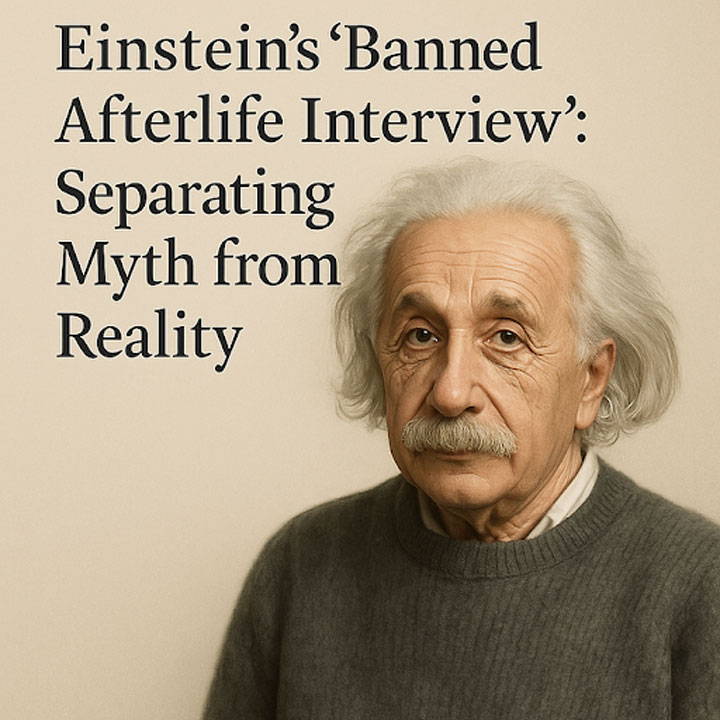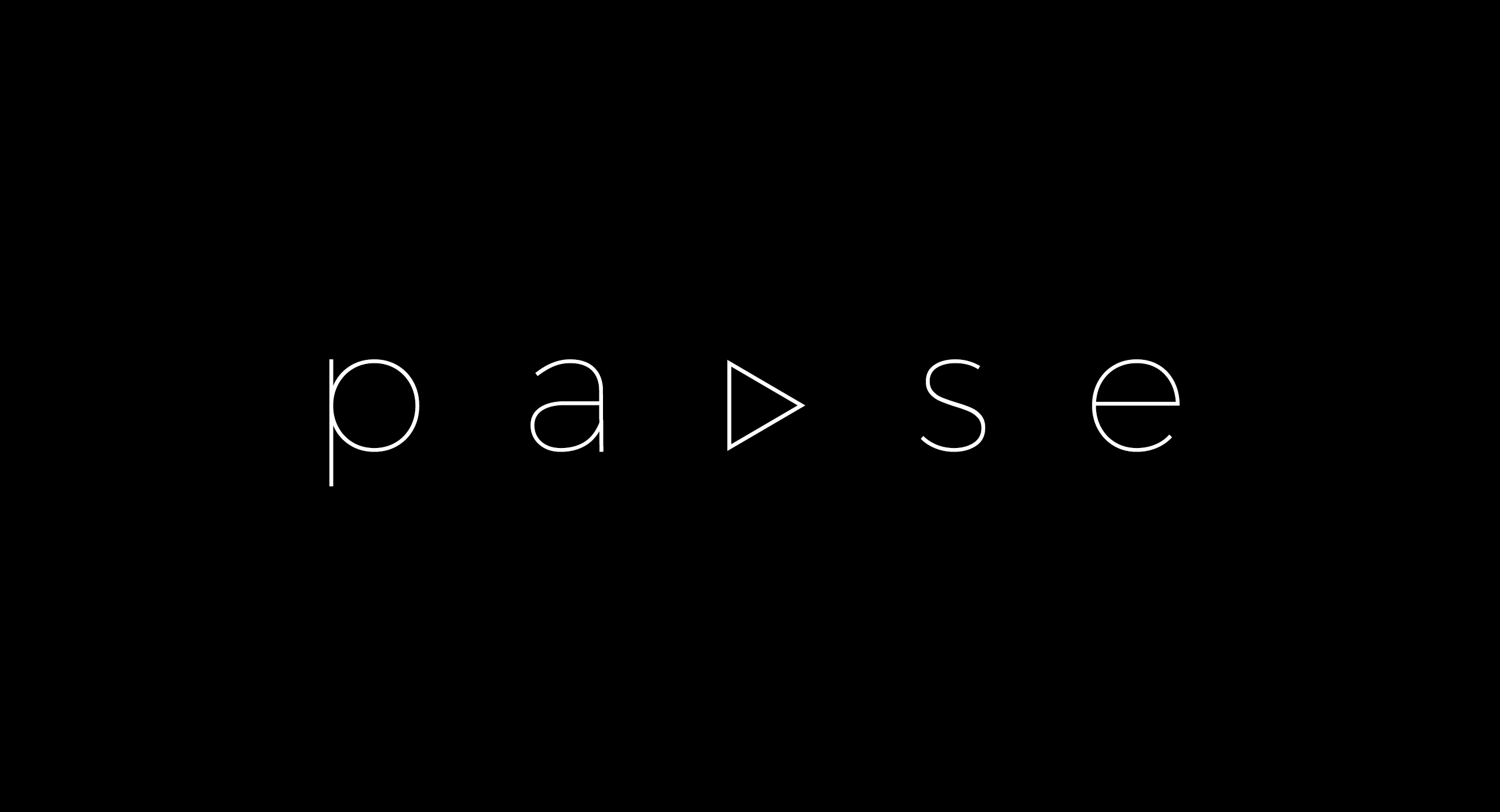Blog
- Separating Myth from Reality
Origin of the “Banned Interview” Narrative
In recent years, a viral story and video have circulated claiming to reveal a “banned interview” in which Albert Einstein discusses the afterlife, the survival of consciousness, and secret evidence supposedly preserved by his friend, mathematician Kurt Gödel. The video’s description dramatically refers to a “recently uncovered hidden archive” and presents Einstein as if he had given an interview about “consciousness beyond the brain” and “death as transformation.” In truth, no historical record of such an interview exists, neither in Einstein’s extensive archives nor in Gödel’s papers. Researchers note that there is zero evidence Gödel ever recorded or “hid” an Einstein interview about life after death. Gödel’s archived writings focus on his own work and beliefs, not secret confessions from Einstein. In fact, the YouTube video appears to be a fictional narrative (its own description calls it a “story designed to awaken thought and curiosity”) rather than an authentic historical source. In short, the “banned interview” is a modern myth with no basis in documented reality.
Einstein’s Actual Views on Afterlife and Consciousness
Far from hinting at any secret belief in an afterlife, Albert Einstein consistently rejected the idea of personal immortality. He was very clear that he did not believe individual consciousness survives physical death. “One life is enough for me,” Einstein said plainly. In his essays and letters, he often explained that he found the notion of a personal afterlife or a God who rewards and punishes to be naive. For example, in The World As I See It (1934) he wrote that “I do not believe in the immortality of the individual”, calling such beliefs the product of fear or “egoistic desires.” Einstein’s stance was that when we die, we cease to exist as conscious selves, and our ethical legacy is all that remains. He aligned with a humanist, agnostic outlook, admiring the awe of the “mysterious” in nature, but denying any literal survival of the mind or soul after death.
It’s important to note that Einstein did use poetic language at times which, taken out of context, has fed afterlife speculations. Most famously, upon the death of his lifelong friend Michele Besso in 1955, Einstein wrote a consoling letter saying: “Now he has departed from this strange world a little ahead of me. This is of no significance. For us believing physicists, the separation between past, present and future is only an illusion, however persistent.”. This line, often misquoted as “the distinction between past, present, and future is a stubbornly persistent illusion”, is not a mystical claim that death isn’t real. Einstein was referring to the block universe view of time in relativity theory (in four-dimensional spacetime, all moments, past and future, exist at once). He meant that from the physicist’s perspective, Besso’s life remains eternally present in spacetime. He did not mean Besso’s consciousness lived on in some spiritual realm. In fact, Einstein added that the departure “means nothing”, emphasizing that physics, not superstition, shaped his view of death. Thus, whenever Einstein spoke of “life and death” in a cosmic sense, he was invoking science (relativity), not endorsing a personal afterlife. Nowhere in Einstein’s genuine writings or interviews does he ever claim that human consciousness survives bodily death. On the contrary, he regarded the end of life as the end of the individual, with only our contributions to humanity living on in memory.
Einstein and Gödel:
Friends with Different Beliefs
It’s easy to see why Kurt Gödel’s name gets entangled in this story. Einstein and Gödel were close friends during their years together at the Institute for Advanced Study in Princeton. In Einstein’s later years (the 1940s and early 1950s), he sought Gödel’s company almost daily, walking home together and engaging in deep conversations. Einstein cherished these talks, once remarking that he came to the Institute “merely to have the privilege of walking home with Gödel.” They discussed physics, mathematics, philosophy, and politics at length. It’s very plausible that topics of mind and reality came up, especially since Gödel himself had strong metaphysical leanings.
Notably, Gödel’s personal beliefs did include ideas about God and even an afterlife, views quite unlike Einstein’s. A biographer recounts that “unlike Einstein, Gödel was a theist…He believed in a personal preexistence and afterlife.” Indeed, Gödel quietly developed a logical ontological proof of God’s existence, and in 1961 he wrote a series of letters to his mother arguing that reason and logic suggested we survive death. Gödel’s rationale was that if the world is rationally organized and meaningful, it would not make sense for human beings to have such rich inner lives and potential only to disappear completely at death. These letters, found in Gödel’s archives decades later, show Gödel’s belief in an afterlife. However, they do not say anything about Einstein sharing that belief; they were Gödel’s private musings. In fact, Gödel was very private about his religious ideas during his lifetime, and Einstein, a religious skeptic, did not publicly endorse Gödel’s views on these matters.
Despite their friendship, there is no evidence that Einstein ever adopted Gödel’s belief in an afterlife. On the contrary, Einstein gently respected Gödel’s right to his own views but remained non-religious himself. Biographical accounts note that Einstein and Gödel often “stood very skeptically opposed” to each other’s pet ideas in discussions. For example, Einstein knew Gödel disagreed with him on some physics (like aspects of relativity or unified field theory), and presumably Einstein did not embrace Gödel’s spiritual convictions. If Einstein had undergone a radical change of heart about consciousness surviving death, it would have been a stunning turnaround completely at odds with his lifelong statements, and surely documented by colleagues. No such shift is recorded. When Einstein died in April 1955, Gödel was distraught at losing his dear friend, but he never claimed Einstein had confided any secret proof of the afterlife. No “hidden archive” from Gödel has ever revealed anything of the sort, only Gödel’s own pro-afterlife arguments, which were well-known by the time they were published in the 2000s. In short, Einstein and Gödel’s relationship was real, but the notion that Gödel somehow safeguarded a “forbidden” Einstein interview or manuscript about the afterlife is pure fiction.
No Record of a Suppressed Interview or “Proof”
The authentic historical record contains no trace of any interview, public or private, where Einstein professes a belief in the afterlife or offers “proof” of consciousness beyond death. Einstein was one of the most documented individuals of the 20th century; his letters, speeches, and interviews have been meticulously archived (the Albert Einstein Archives in Jerusalem hold tens of thousands of documents). Scholars and biographers have combed through these documents for decades. If Einstein had ever given an interview on so dramatic a topic as life after death, it would be widely known. Instead, what we find in Einstein’s archive are consistent statements to the contrary, that he considered personal immortality a “naïve” idea and saw no evidence for a soul independent of the body.
The “banned interview” tale usually claims it was recorded “just before Einstein’s death” and then hidden. It’s worth asking: hidden by whom? By the 1950s, Einstein was a globally revered figure with no obvious censors. He freely expressed his views on science, religion, and philosophy in letters and articles. There was no authority that would or could “ban” an Einstein interview in a democratic society. Moreover, Einstein’s health in his final years was fragile, he wasn’t giving many interviews at all. His last well-known popular essay was “The Religiousness of Science,” published in 1954, which reaffirmed his impersonal religious outlook (Spinoza’s God and awe of nature) and again dismissed any literal afterlife. If he had dramatically reversed his position in a final interview, it would have represented a 180-degree turn. Yet none of his close associates or family ever reported such a conversation. The absence of any credible source or transcript for this supposed interview, combined with the fantastical way it’s presented, strongly indicates it is a fabrication. Even commentators on social media have noted that the story “lacks any supporting evidence” and that Gödel’s papers contain nothing like a secret Einstein confession. Until any concrete archival evidence emerges (and none has), we must conclude the “banned interview” is an Internet-era fable, not a lost chapter of Einstein’s life.
Modern Physics, Entanglement, and Misinterpreting Einstein
Interestingly, the popularity of this Einstein-afterlife myth reflects how modern physics concepts are sometimes misused to fuel mystical narratives. Einstein’s own breakthroughs, relativity and contributions to quantum theory, often get name-dropped in discussions of consciousness and the afterlife. Let’s unpack how these ideas actually relate, and how mainstream science views them:
Relativity and the “Afterlife”: Einstein’s theory of special relativity merges space and time into spacetime, implying a “block universe” where past, present, and future all coexist. Some have latched onto this to suggest “Einstein proved time is an illusion, so perhaps we never truly die.” In relativity, it’s true that what we call “now” is relative, and in a sense all moments are equally real. Einstein himself alluded to this when comforting Besso’s family (the “stubborn illusion” remark). However, this doesn’t mean our consciousness persists or can experience all times. Physics tells us that once a person dies, there is no further subjective experience for that person, they cannot perceive other parts of spacetime. As physicist Sabine Hossenfelder explains, from a block-universe view, your deceased loved one exists forever at those spacetime coordinates where they were alive, but you can no longer interact with them. The information that made up their body and mind isn’t magically preserved as an intact “self”; rather, that information gradually disperses into the environment. Hossenfelder puts it bluntly: “when someone dies, the information that made up their personality disperses into subtle correlations in their remains, entangling with particles around them, and eventually radiating out into the universe.” In other words, no known law of relativity or physics allows a dead person’s consciousness to continue communicating. There is no “relativistic afterlife”, at least not in the sense of an aware mind roaming the cosmos. The enduring lesson of relativity is that one’s historical existence is forever part of spacetime, but as far as living consciousness goes, death is final.
Quantum Entanglement and Consciousness: Einstein famously had reservations about quantum mechanics. In 1935, he and colleagues highlighted the strange phenomenon of entanglement, calling it “spooky action at a distance.” Experiments long after Einstein’s death showed entanglement is real, two particles can be mysteriously correlated no matter how far apart. In recent decades, quantum physics has been a magnet for metaphysical speculation. Some people argue that entanglement or quantum theory might permit consciousness to exist independent of the brain or to “live on” after death. It’s crucial to separate mainstream science from fringe interpretation here. In standard physics, quantum entanglement is a property of small particles and information, it does not by itself imply anything like a soul. No reputable evidence shows human consciousness is quantum-entangled with the universe in a way that would preserve your identity after death. Einstein himself would be skeptical of such claims; he viewed quantum phenomena as puzzling but ultimately rooted in physical law, not magic.
That said, a few scientists have speculated about quantum consciousness. Notably, physicist Roger Penrose and anesthesiologist Stuart Hameroff proposed a controversial model that consciousness arises from quantum processes in brain microtubules. This Orch-OR theory is highly debated and far from proven. Hameroff has mused that if the mind’s quantum information doesn’t depend entirely on the body, maybe it “transcends” when the body dies, perhaps remaining as a kind of quantum state in the universe. In their view (which is not widely accepted by neuroscientists), “consciousness is fundamentally quantum and energy-like, so it might persist or transform rather than vanish”. Such ideas blur into philosophy: e.g. “energy doesn’t die, it only changes form”, implying maybe our awareness could become diffused energy. These notions are speculative and on the fringe of science. They should not be attributed to Einstein, who never said anything of the sort. At most, one can say modern quantum theory has inspired new questions about consciousness, but no experimental evidence yet indicates minds exist apart from brains. The consensus in neuroscience and physics is that when the brain stops, consciousness as we know it ceases.
Misuse of Einstein’s Legacy: Einstein’s name often gets attached to grandiose spiritual claims to lend them credibility. Over the years, many fake quotations and apocryphal stories have been attributed to him. The “banned interview” appears to be one more example of using Einstein’s cultural authority to promote a mystical message. While Einstein had a deep sense of wonder about the universe, he was also a skeptical empiricist. He insisted that claims, especially about something as extraordinary as life after death, require extraordinary proof, which he never saw. It’s telling that Einstein’s real statements about God and immortality portray a very grounded, naturalistic worldview. For instance, in a 1950 letter he flatly stated, “I do not believe in immortality of the individual, and I consider ethics to be an exclusively human concern with no superhuman authority behind it.”. This is a far cry from the fantastical tone of the “forbidden interview” videos.
In summary, modern physics does not endorse the idea of a personal afterlife, and Einstein did not secretly do so either. Concepts like entanglement or the relativistic block universe are sometimes stretched beyond their actual meaning in order to claim scientific backing for spiritual beliefs. Such interpretations remain fringe. Mainstream scientists, including Einstein in his time, maintain that consciousness is a phenomenon emergent from physical processes, and when those processes irreversibly stop (death), the person’s conscious experience ends. While physics offers mind-bending insights about time and space, it has never provided evidence of mind independent of body.
Conclusion:
No Secret Einstein Manuscript, Just Enduring Myths
The legend of a “banned” Einstein interview about the afterlife is just that, a legend. It appears to have originated from modern storytellers rather than any 1940s or ’50s source. No credible historical documentation backs it up, and it clashes with everything we know about Einstein’s actual beliefs and character. Albert Einstein never claimed to have proof of life after death. In fact, he openly denied that notion, even if he offered poetic comfort about our place in the spacetime tapestry. His friend Kurt Gödel did believe in an afterlife, but that was Gödel’s personal conviction, not a scientific discovery, and Einstein did not suddenly convert to it. There is no hidden archive of Einsteinian afterlife evidence waiting to be revealed, Gödel’s saved letters argue his own case for immortality, and they were published decades ago with great scholarly interest. Yet none of those letters suggest Einstein agreed with him.
Finally, it’s worth appreciating why this myth resonates. It mixes our desire for cosmic meaning with the authority of Einstein’s name. It hints that science’s greatest mind might have glimpsed something transcendent, a tantalizing thought. But part of Einstein’s true legacy is the ability to distinguish wishful thinking from reality. He famously said “science can only ascertain what is, not what should be”, cautioning that we must keep facts and values separate. The facts are that Einstein approached questions of existence with wonder and skepticism. He found no scientific basis for an afterlife and was intellectually honest about that, even if it offered less comfort than we might wish. Embracing Einstein’s real stance, grounded in evidence, open to mystery but not to unfounded claims, is far more in the spirit of his legacy than any “forbidden interview” fantasy.
Sources:
Einstein’s own words on religion and afterlife (via The World As I See It and letters)
Archive evidence from Einstein and Gödel (or lack thereof)
Accounts of Einstein and Gödel’s friendship (Morgenstern’s letter, Hao Wang’s recollections)
Sabine Hossenfelder’s physics perspective on death and information
Quote Investigator on Einstein’s “time illusion” letter to Besso
Discussion of quantum consciousness theories and their speculative nature.




No Comments
Signup or login to leave a comment